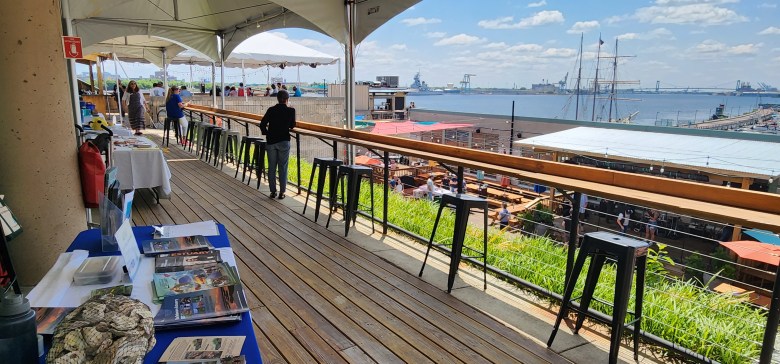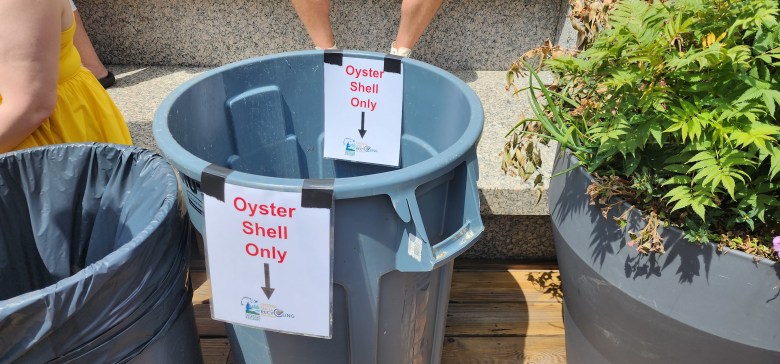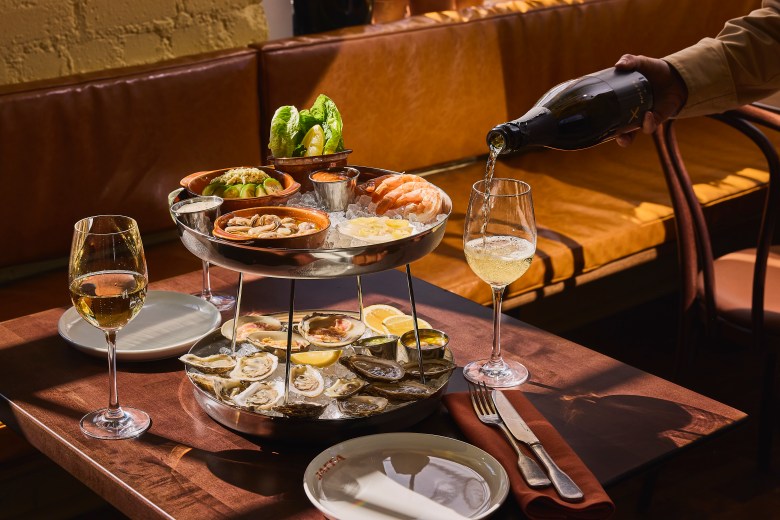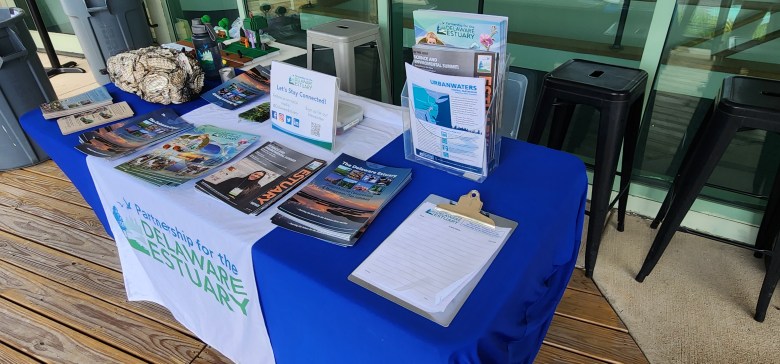Want to help improve Philadelphia’s waterways? Experts have this advice: Eat more oysters.
As the summer season approaches, so does the time for peak oyster enjoyment. And there’s no better time to start slurping up those slippery suckers than this weekend. The Partnership for the Delaware Estuary (PDE), a local environmental nonprofit that works to protect the Delaware River and Bay, is teaming up with Oyster House’s Shuckfest, Philly’s annual oyster celebration.
Together, the restaurant and nonprofit will work to recycle every single shell used at the festival, which runs Sunday from 12 to 3:30 p.m at Liberty Point at the Seaport Museum.
The PDE has spent almost a decade expanding its oyster shell recycling program. The initiative collects used shells from restaurants and repurposes them to create environmentally-friendly and beneficial reefs in the Delaware River.

“We do a lot of living shoreline work and living shoreline implementation,” said Leah Morgan, the assistant manager of estuary science at the PDE. “The reef itself is also very good at protecting the coastline from all of those risks, like storm surge, coastal flooding. So by reintroducing this material back into areas where it is typically or was once very ubiquitously found, it’s really beneficial.”
Recycled oyster shells can play a crucial part in restoring Philly’s waterways – helping improve water quality through filtration, serving as a habitat for baby oysters and protecting the shoreline from erosion. Shuckfest will be serving up thousands of shells, which will then be used in the program.
“Each farmer will bring 800 oysters, and we have 12 local oyster farms,” said Sam Mink, the owner of Oyster House and festival organizer. “And then we have the oysters for ‘the learning how to shuck’ table, so that’s a few hundred oysters. And then we have the oysters for the shucking competition. It’s a few hundred oysters, so I would say upwards of 10,000 oysters.”
With this many mollusks on hand at the festival, this weekend is sure to not only be great for your taste buds, but also for the Delaware River’s shoreline.
‘A full circle process’
The PDE’s oyster recycling program launched in 2016, and in the last decade the program has grown bigger and bigger – now collecting from eight different Philly restaurants and two storefronts. Last year, the organization collected a total of 134,482 pounds (more than 67 tons!) of oyster shells to return to the shoreline, which is seven times more than they were collecting in 2020.
Picking up all these shells around town is no small feat. Ken Williamson, an oyster restoration specialist, has become the go-to guy at the PDE when it comes to collection. Twice a week he drives to restaurants around Philly and loads barrels of oysters into his Chevy Silverado pickup truck. The practice, he says, has brought some attention around town.
“I definitely do have a rapport with some of the people in some of the restaurants, or even just some of the people around the city I run into,” he said. “There’s a mailman that has a similar route in Fishtown. We’re always vying for the same parking space. And we’re like, ‘Oh, hey.’ We chat all the time now and wave at each other.”
Parking with a big truck full of oysters is no joke.
“You know, sometimes I’ll park and stop somewhere, get something to drink, or a coffee. And anybody near me, people in convertibles, are like, ‘Oh my God. What is that?’ If it’s full of shells, the smell is pretty strong in the summer.”
Once the shells are collected, they head to a management area and sit outside for at least six months to go through a curing process.

“During this curing process, the shell is exposed to the elements,” Morgan said. “It’s faced with sometimes extreme heat, sometimes extreme cold, rain, snow, sleet, any type of weather that will effectively clean the shell – in addition to bugs kind of scavenging on it and eating any leftover bacterial or biological material.”
Eventually, after enough time, each shell will be “biologically secure” enough to go back in the waterway and serve as part of a reef. There, they work their magic and help the local shoreline – improving sediment, protecting the coast, filtering the water, mitigating storm surge and expanding marsh grasses.
What’s more, the shells work as a natural habitat for marsh animals and other critters.
“The actual shell itself is a really great substrate for baby oysters,” Morgan explained. “So recycled oyster shell, or dead oyster shell that exists on a wild reef, is the ideal material for a larval oyster in its initial stage of life to come and latch onto and grow to an adult size and build a reef.”
“The shell reef helps them and provides protection,” she added. “It becomes a full circle process for these little guys, who will grow strong and then we can eat them and use their shells again.”
Sustainable seafood
Initiatives like the oyster recycling program at the PDE are a reminder to Philadelphians that eating seafood can be a sustainable practice.
Bryan Szeliga, the owner of Fishtown Seafood, was one of the early adopters of the program and has worked to help the PDE expand the initiative into new restaurants.
“Don’t let the narrative of ‘farm-raised fish is bad,’ or ‘seafood is bad,’ or ‘the oceans are going to be empty by 2025’ — don’t let that narrative scare you from not eating fish,” Szeliga said. “We as humans need to eat more seafood … Earth is covered by roughly 70% water, and only 18% of the animal proteins we consume comes from the ocean, with half of that being farm-raised and half being wild.”
Part of Szeliga’s mission at Fishtown Seafood is not only to sell quality, sustainable products, but also to educate eaters on environmentally friendly dining practices. Fishtown Seafood sells oysters from all over the East Coast.

“I’ve just kind of, over time, fallen in love with this very unique industry,” Szeliga said. “Most chefs might know how to cook seafood, but chefs don’t know anything about seafood and the supply chain, and that’s one of the things that we are able to do and offer: to explain it to people.”
One of the newer adoptees of the oyster shell recycling program is Jaffa Bar. Chef Andrew Henshaw said that opting into the program was a “no brainer,” because it reduces the restaurant’s waste and is a free service that helps local waterways.
The chef serves a wide variety of oysters at the restaurant with different mignonettes and cocktail sauce.

“The mignonettes include a Yemenite-style chili paste with serrano peppers, jalapeno peppers, parsley, cilantro, garlic and ginger with coriander and cardamom,” he said. He calls the mixture “floral and bright.”
“The mignonette is a little bit spicy. It’s a little bit sour from the vinegar in there, and then kind of adds savoriness from the shallots,” he said. “And then you put it on top of a super-salty, briny oyster. And it’s just like such a cool experience to eat.”
Each oyster is unique
Shuckfest will be outside at Liberty Point, with a view of the Delaware River. The festival includes an amphitheater with live music, dancing and a shucking competition – where competitors are graded not only on how quickly they can shuck, but the quality of their work – as well as a table where everyday festival goers can learn how to shuck an oyster. There will also be an outdoor beer garden and delicious bites.
For those who haven’t liked oysters, perhaps due to their raw and slippery nature, both Szeliga and Mink suggest it’s worth it to give them another try.

“It’s almost like someone saying, ‘I don’t like wine,’ ” Szeliga said. “Well, what wine did you have? Where did you have it from? Certain red wines are different than white wines, and there are different geographies and different varietals, etc. It all makes for completely different experiences of oysters. So a Gulf oyster [or a] Chesapeake Bay oyster is going to have a different flavor profile, different salinity than something that is coming out of Atlantic Canada or Maine, etc.”
Mink echoed this sentiment, explaining that, for skeptics out there, it’s OK to be choosy.
“I’m not going to tell anyone that they’re wrong if they don’t like something,” he said. “But I would suggest that they try a freshly shucked oyster. So if they had an oyster and they didn’t have a good experience, I would ask, why? Where was it? What kind of oyster was it? How is it shucked?”
A good oyster should taste fresh like the water it comes from and can have a buttery feel. For those interested in learning more about the PDE’s oyster recycling program, Shuckfest will have a whole table dedicated to the initiative.
“We just hang out as people pass by,” Williamson said. “We speak with them, try to get people to sign up for our newsletter. Occasionally, we’ll talk to somebody who’s a restauranteur or somebody who has a larger interest in maybe contributing to the program while we’re there, which is what we’re hoping for.”

Mink is looking forward to this weekend, and said he is expecting around 400 people to come out and participate. Tickets are $80 and attendees get to sample two dozen oysters from 12 different local oyster growers. Proceeds will help support the Jetty Rock Foundation and the PDE.
“We’re happy to be celebrating all of our local oyster farmers,” Mink said. “It’s a great way to sample what we have in our local oyster industry.”
“Back in the day, we used to have so many oyster bars [in Philadelphia],” he added. “They used to be very popular, and they kind of went by the wayside. And oyster bars have been coming back recently, much more popular than they ever have, at least in our lifetime. But we had a strong oyster industry for quite a while, and it died down, and we’re happy to be back and celebrating.”



